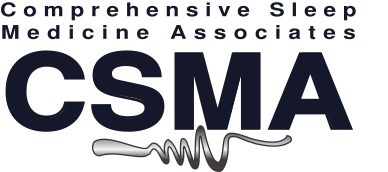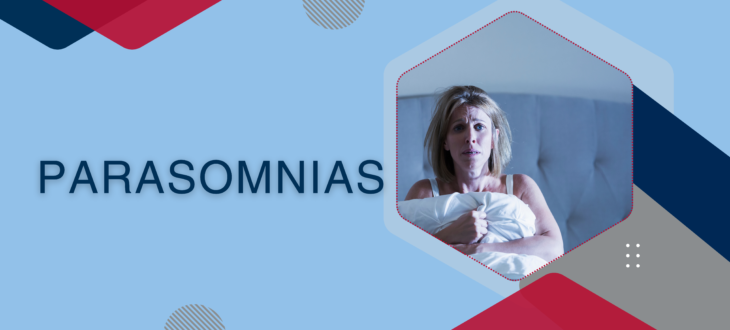Parasomnias refer to a variety of disruptive sleep-related events that occur only or predominantly during the main sleep period. These include sleep starts, bruxism, confusional arousals, sleepwalking, sleep terrors, nightmares, bed wetting, sleep paralysis and REM sleep behavior disorder.
-
- Sleep Starts: Most people at one time or another experience sleep starts. The most common experience is that of a sudden, often violent jerk of the entire body at sleep onset. Others may include visual or auditory phenomena. Such occurrences can be frightening, but they are perfectly normal unless they become a regular disturbance to sleep.
- Bruxism or Teeth Grinding: This is a fairly common occurrence. This may be related to medical or psychological problems, but in most cases it occurs independently. In severe cases a dental appliance may be needed to prevent injury to the teeth.
- Confusional Arousals: This can occur at any age. They consist of confusion during and following arousals from sleep, usually from deep sleep early in the night. The individual is disoriented as to time and space, has slow speech and slow thinking, and responds poorly to commands or questioning. Behavior may be very inappropriate and can last from several minutes to hours.
- Sleepwalking: This is most commonly seen in children. It usually occurs during slow wave (deep) sleep and occurs most often during the first third of the night. It ranges from simply getting out of bed to prolonged and complex actions, including going to another part of the house or even outside. Sleepwalkers might carry on conversations and act out complicated behaviors that are difficult to understand and may make little or no sense. In some cases, individuals may actually eat during an episode (nocturnal eating syndrome).
- Sleep Terrors: These are an extreme form of sleepwalking and are distressing to witness. They occur more commonly in children. These episodes often begin with a scream or shout with resulting behaviors that suggest extreme terror and agitation. The child may bolt out of bed, run around and hurt themselves. As disturbing as these events are, individuals having them are usually totally unaware that they have occurred when they awaken the next day.
- Nightmares: These can occur at any age and are a phenomenon of REM sleep. REM sleep is the stage of sleep in which vivid dreaming occurs. Fright or anxiety is an essential part of the nightmare experience. There is usually some memory of the dream content the next day.
- Sleep Paralysis: As the name indicates, this is the experience of awakening with a feeling of being unable to move. This usually occurs following a dream and can occur at any age.
- REM Behavior Disorder: This most often occurs in older individuals and is characterized by the appearance of elaborate motor activity associated with the person’s dream. Normally during REM sleep the muscles of the body become paralyzed to prevent the body from acting out dreams. In people with REM behavior Disorder the muscle paralysis system of the brain does not work correctly. The individual may punch, kick, leap and run from the bed during dreaming. An injury may occur to either the person or the bed partner. This can be treated to prevent the person from acting out their dreams.
- Bed Wetting (Sleep Enuresis): While this is normal during infancy, it is something that should resolve by age 5 or 6. If it occurs at older ages, then it may be a result of a medical problem such as a small functional bladder capacity or from abnormal neurological bladder control. Psychological factors can cause this problem as well. There are treatments available to improve the problem, and these should be discussed with a physician.
- Night Terrors: These occur during a phase of deep non-REM sleep usually within an hour after the subject goes to bed. This is also known as stages 3, 4, or delta sleep. During a night terror ,which may last anywhere from five to twenty minutes, the person is still asleep. The sleepers eyes may be open, but they are not awake. When the subject does wake up, the subject usually has no recollection of the episode other than a sense of fear. This however is not always the case. Quite a few people interviewed can remember portions of the night terror, some remember the whole thing. Unlike nightmares, which are frequently dreams of a frightening nature, night terrors are not recalled dreams. Usually there is no situation or event (scary or otherwise) that is dreamt, but rather the emotion of fear itself is felt. Often, this is coupled with tension and apprehension without any distinct sounds or visual imagery, although sometimes a vague object of fear is identified by the sufferer. These emotions, generally without a focusing event or scenario, increase emotions in a cumulative effect. The lack of a dream itself leaves those awakened from a night terror in a state of disorientation much more severe than that caused by a normal nightmare. Children from age two to six are most prone to night terrors, and they affect about fifteen percent of all children, although people of any age may experience them. Episodes may reoccur for a couple of weeks then suddenly disappear.
For further reading, Click Here for the .pdf poster “Treatment of REM Behavior Disorder with Acetylcholinesterase Inhibitors” by Jerald H. Simmons, M.D.

